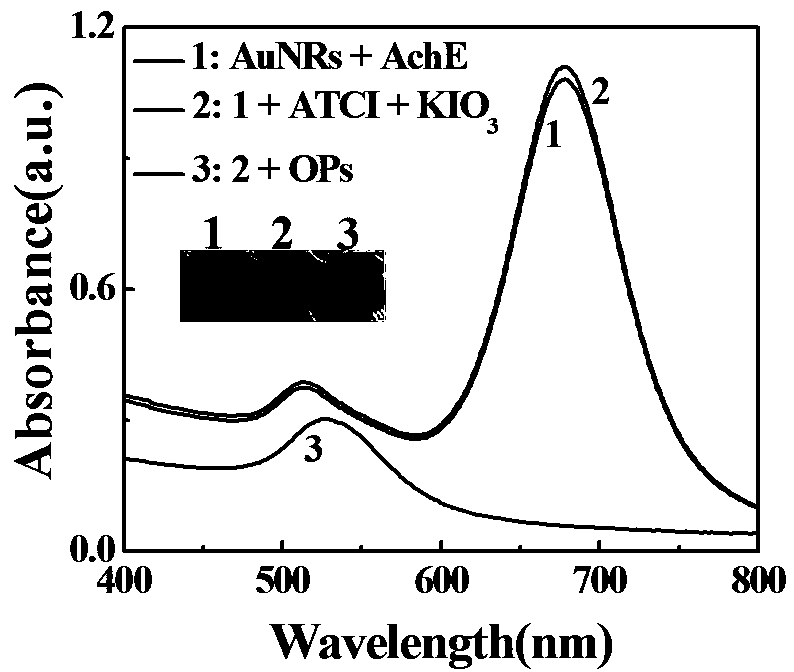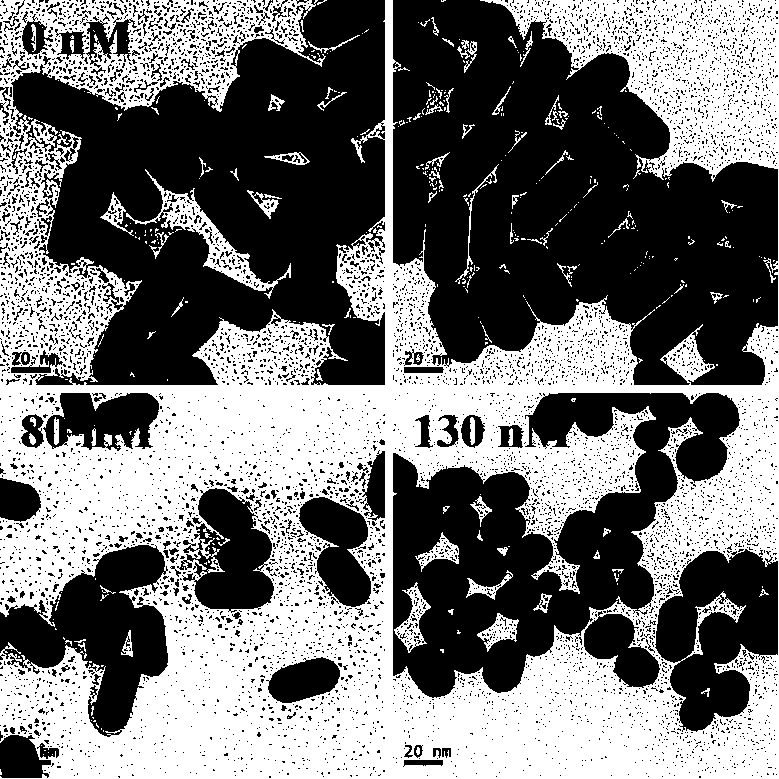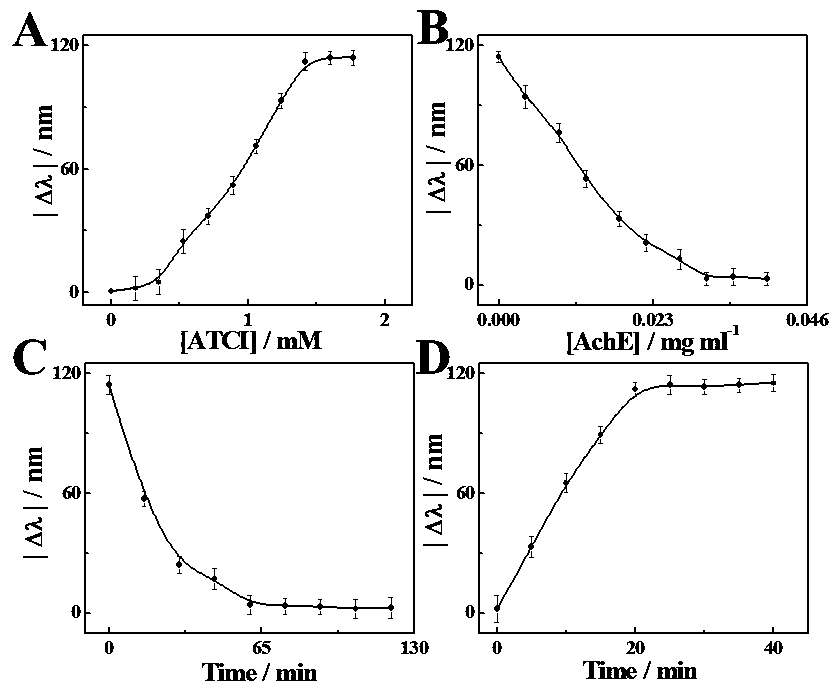Visual colorimetric detection method of organophosphorus pesticides
An organophosphorus pesticide and detection method technology, applied in the fields of nanotechnology and analysis and detection, can solve the problems of professional operation technology limitation, time-consuming and other problems, and achieve the advantages of overcoming the long detection time, simple operation, good social value and application prospect. Effect
- Summary
- Abstract
- Description
- Claims
- Application Information
AI Technical Summary
Problems solved by technology
Method used
Image
Examples
Embodiment 1
[0032] Example 1 Feasibility verification of visual colorimetric detection method for organophosphorus pesticide detection
[0033] Prepare the solutions required for the construction of a visual colorimetric sensor: put the synthesized gold nanorod stock solution at room temperature for use, prepare 250 μg / mL acetylcholinesterase solution, prepare 100 mM ATCI solution, and prepare 0.41 mM KIO 3 solution, prepare glycine-hydrochloric acid buffer solution (pH 2.2), and place it in a refrigerator at 4°C until use.
[0034] The effect of each reaction component on the spectral signal was systematically investigated by the single variable method.
[0035] (1) Add 250 μL of glycine-hydrochloric acid buffer solution (pH 2.2) into an EP tube with a volume of 0.5 mL;
[0036] (2) Add 250 μL of gold nanorod stock solution;
[0037] (3) Add 8 μL of acetylcholinesterase solution (250 μg / mL), 20 μL of KIO 3 solution (0.41 mM) and 8 μL of ATCI solution (100 mM), mix gently, and place in...
Embodiment 2
[0041] Example 2 Transmission Electron Microscopy (TEM) Characterization of Organophosphorus Pesticide-regulated Gold Nanorod Etching
[0042] Using different concentrations of organophosphorus pesticide solutions, the effects of different concentrations of organophosphorus pesticides on gold nanorods were intuitively analyzed.
[0043] (1) Add 8 μL of acetylcholinesterase solution (250 μg / mL) and 10 μL of organophosphorus pesticide solution into a 0.5 mL EP tube, mix well, and incubate at room temperature for 25 min;
[0044] (2) Add 8 μL of ATCI solution (100 mM) to the mixed solution in (1), mix gently, and incubate in a water bath at 37 °C for 60 min;
[0045] (3) Add 250 μL of glycine-hydrochloric acid buffer solution (pH 2.2) into an EP tube with a volume of 0.5 mL;
[0046] (4) Add 250 μL of gold nanorod stock solution and 20 μL of KIO 3 solution (0.41 mM), gently mix;
[0047] (5) Add the mixture in (2) to (4) and mix gently, place in a water bath at 50°C for 15 minut...
Embodiment 3
[0049] Example 3 Optimization of Experimental Conditions for Visual Colorimetric Detection Method for Detection of Organophosphorus Pesticides
[0050] Through the single variable method, the influence of each reaction factor on the ultraviolet spectrum signal was determined respectively.
[0051] (1) ATCI concentration optimization: Take 250 μL of glycine-hydrochloric acid buffer solution (pH 2.2) and add it to an EP tube with a volume of 0.5 mL; then add 250 μL of gold nanorod stock solution and 20 μL of KIO 3 solution (0.14 mM), mix gently; finally add different volumes of ATCI solution (100 mM), mix gently, and place in a water bath at 50 °C for 15 minutes; directly measure and record the absorption of each group of solutions in the range of 400 nm-800 nm The peak position value was obtained to obtain the influence of different concentrations of ATCI on the formation of the visual colorimetric sensor and the ultraviolet spectrum, and the experiment was repeated three times...
PUM
 Login to View More
Login to View More Abstract
Description
Claims
Application Information
 Login to View More
Login to View More - R&D
- Intellectual Property
- Life Sciences
- Materials
- Tech Scout
- Unparalleled Data Quality
- Higher Quality Content
- 60% Fewer Hallucinations
Browse by: Latest US Patents, China's latest patents, Technical Efficacy Thesaurus, Application Domain, Technology Topic, Popular Technical Reports.
© 2025 PatSnap. All rights reserved.Legal|Privacy policy|Modern Slavery Act Transparency Statement|Sitemap|About US| Contact US: help@patsnap.com



